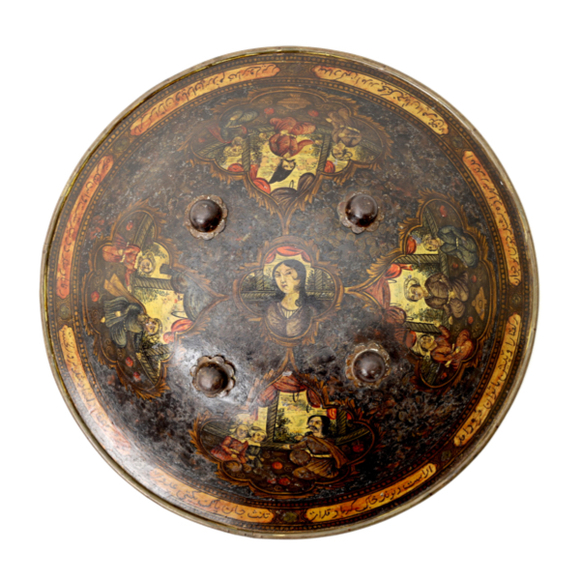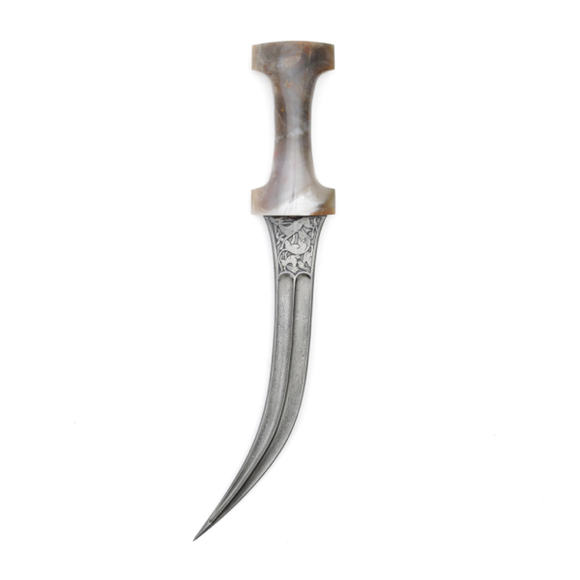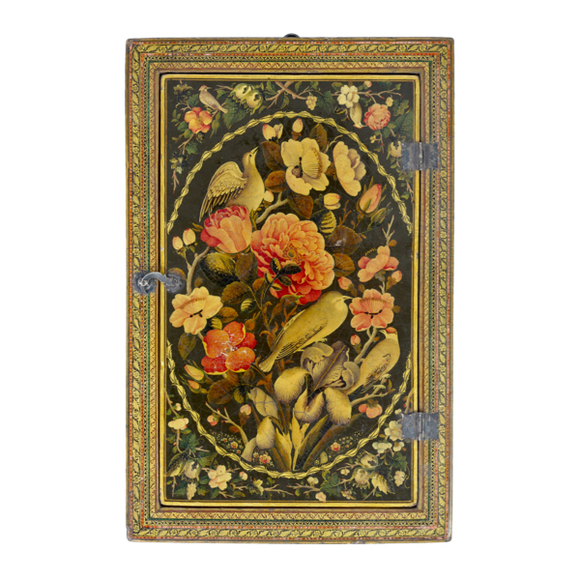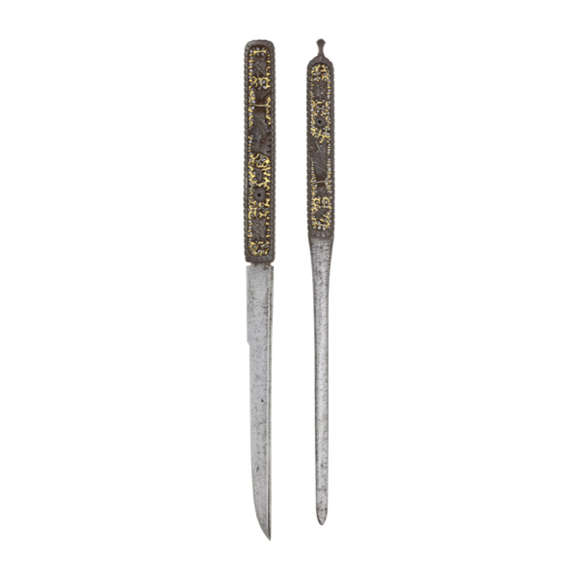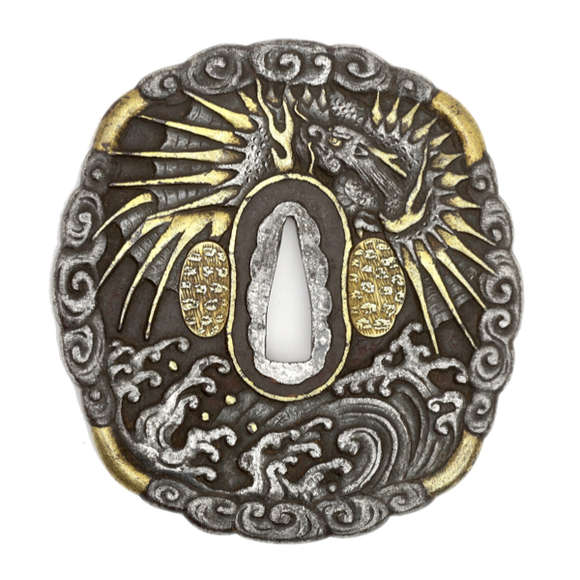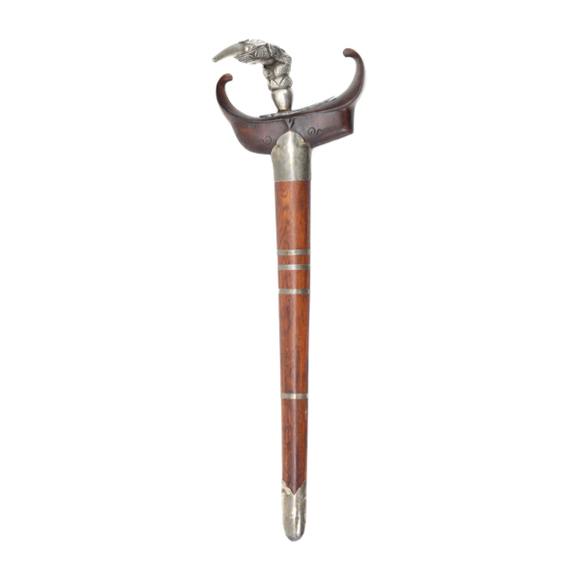Persian steel shield with fine Qajar style painted dome.

33.9 cm
23.3 cm
Base 45.6 mm
Middle 27.5 mm
Tip 7.2 mm
Base 7.5 mm
Middle 6.5 mm
Tip 4.5 mm
271 cm
17 mm from hilt
Brilliant black wootz blade
New green stone hilt
Blade: Persia
Hilt: Unknown
Blade 18th century
Hilt probably 20th century
From a UK private collection
Introduction
Among blade steel, wootz is highly prized among collectors. The patterns in this steel were not created by forge folding, like those of other types of fighting steel, but instead formed in a crucible. The basic process involved plant leaves and iron ore being smelted in a crucible covered with a seal of molten glass so the carbon could not oxidize and evaporate, but was forced to react with the iron. Crystalline structures formed across the steel during a long cooling process, making a steel that could be tempered very hard but retained a toughness not seen in other high-carbon steels. We now know that this process created carbon nanotubes, one of the most advanced materials of our day. And yet, the process of making wootz is well over 2000 years old.
But not all wootz is created equal. Production of the special steel at some point was done in Sri Lanka, South India, North India, the Ottoman Empire, and even in the Balkans. Initially, it was primarily prized for its properties, not its patterns, and many older wootz blades were buffed to a mirror shine and were not etched to reveal them.
It were the Persians who perfected the enhancement of the visual effects of wootz. The gentle hammering of small recesses into the blade's surface and then polishing them flat again gave makers further control over the grain, leading to bold burl patterns and other effects. In order to enhance the visual appeal of this work they created types of wootz with ever higher contrast between the layers.
This lead to the most prized wootz of all, the "brilliant black" wootz of Persia; "Kara Khorasan".
This example
A fine Persian khanjar blade, mounted on a recent stone hilt.
The blade is made of high-quality brilliant black wootz. The blade has a wide base and a gradual curve, slightly less abrupt than they would become in the 19th century. It has a very strongly pronounced center ridge on both sides. The base is tastefully chiseled, leaving two raised panels and narrow raised lines. Their cusped outlines remind of the scalloped archways that first emerged under the Umayyad Caliphate.
Comparable examples
A dagger with a very similar blade was acquired by Queen Victoria and Prince Albert. The metal hilt is of a type that appears to have been made in Shiraz. Date of acquisition is unknown, but they were photographed between 1853-1855.

Three daggers acquired by Queen Victoria and Prince Albert
Photo by Charles Thurston Thompson (1816-1868)
Royal Collection Trust accession number RCIN 2369583
Another with a similar design on the base of the blade was in the P. Holstein collection.1 It, too has a hilt of a style that is attributable to Shiraz, which increases the likelihood that the blades are also from that area.

Khanjar in the Holstein collection.
It has a very similar hilt to the piece in Queen Victoria's collection.
Dating
The blade's profile and the style of the chiseling at the base make me attribute it to the late 18th century. Blade curvature tended to be more subtle at the start of the 18th century, as exemplified by a signed piece in the Aga Khan Museum.2 The deeply curved profile with a wide base appears to have developed before the closing of the 18th century, as it appears on a 1799-1800 dated example in the private collection of Dmitry Miloserdov.3
The raised chiseled decoration is another hint towards an 18th-century attribution, as the typical Qajar period work usually consists of more superficially carved designs where the highest points of the design are flush with the surface of the forte, instead of rising above it as is the case here.
There is a dagger with a blade with similar chiseled designs in the Military Museum of Tehran, attributed to the Zand period (1751–1779 AD).4 Two others are quite safely put in the Qajar period, which spanned from 1789 to 1925 AD.5 Another quite similar blade is published in Holstein, but no date is given. 4
Notes
1. P. Holstein; Contribution à l'Etude des Armes Orientales. Paris. Les Éditions Albert Lévy. 1931. Vol. 2. Plate LX. Description on page 196-197.
2. Dagger and sheath, accession number AKM963.
3. See my glossary article; khanjar. It was dated 1214 Hijri, this year ran from July 4th, 1799 to May 29, 1800 on the Gregorian calendar.
4. Asadollah Matufi; Tarikhe Char Hezar Saleye Artesh Iran: Az Tamadon Ilam Ta 1320 Khorshidi, Jange Iran Va Araq. (The four-thousand-year History of Iranian Military: From the Elamite Civilization to the Year 1320, The Iran, Iraq War.) 1999. As quoted in Dr. Manouchehr Moshtagh Khorasani; Arms and Armor from Iran. Legat Publishing, 2006. Cat 214.
5. Dr. Manouchehr Moshtagh Khorasani; Arms and Armor from Iran. Legat Publishing, 2006. Cat 217 and 218.









Nice Persian dagger with fine wootz blade and unusual hilt material.
Made of pasteboard, finely lacquered with roses and nightengales.
The only set of its type known to me in both private and museum collections.

